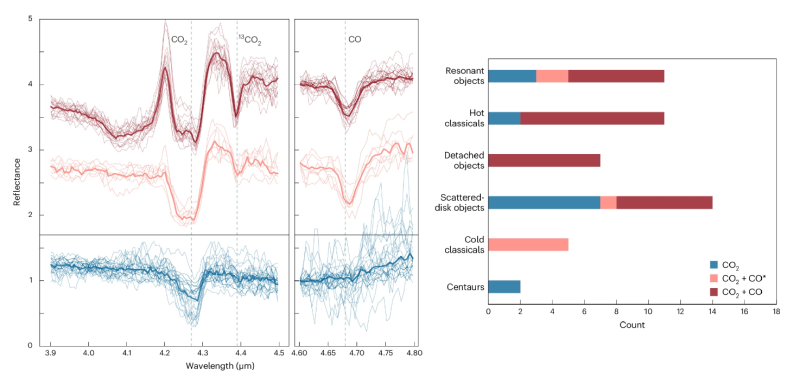Follow us on Google News (click on ☆)

TNOs have also witnessed planetary migration processes that have redistributed most of them far from their formation regions. To date, observations of TNOs have been limited, providing only a partial characterization of their chemical composition: only water and methanol ices were detected on a handful of objects.
A major observation program by the James Webb Space Telescope recently provided the first comprehensive view of TNOs. The observations of 59 objects obtained with the NIRSpec instrument were analyzed by an international research team involving scientists from CNRS Earth & Universe. The infrared spectra reveal the very first detections of CO2 and CO ices on small bodies in the outer Solar System.
Against all odds, CO2 is very widespread, present on 95% of the objects although in varying proportions. While CO is not stable in the trans-Neptunian region, it is nonetheless detected alongside CO2 on 47% of the objects. This diversity in composition, reflected by variations in abundance as well as the physicochemical state of the ice, will help to trace the history of TNOs to pinpoint their formation location in the protoplanetary disk.
If CO2 could have been inherited from the protoplanetary disk, CO is more likely formed through the interaction of the surface with solar wind and cosmic rays. Remarkably, 13CO2 is also detected, which opens up the possibility of studying the isotopic ratio of carbon across the outer Solar System.

Infrared signature of the fundamental bands of CO2 and CO on TNO surfaces (left) and the distribution of their detection among different dynamic groups of TNOs (right).
© De Prá et al., Nature Astronomy, 05/24.
Reference:
De Prá, M.N., Hénault, E., Pinilla-Alonso, N. et al.
Widespread CO2 and CO ices in the trans-Neptunian population revealed by JWST/DiSCo-TNOs.
Nat Astron (2024).